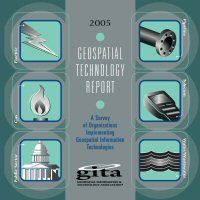 GITA rolled
out its Geospatial
Technology Report last month.Again delivered on CD, the 249 page
report covers the "scope, uses, and funding" of geospatial projects
around the world.(A quick count found 15 non-US participants.) The
cost is $259 for GITA members and $399 for nonmembers.What do you get
for that investment?
GITA rolled
out its Geospatial
Technology Report last month.Again delivered on CD, the 249 page
report covers the "scope, uses, and funding" of geospatial projects
around the world.(A quick count found 15 non-US participants.) The
cost is $259 for GITA members and $399 for nonmembers.What do you get
for that investment?The Respondents and the Data
The reader will find a compilation of the responses of the 249 responding organizations (a 44% increase over the last edition). Numbers of participants range from 108 in public sector to 19 in telecom.There are the familiar lists of top applications/technologies in each industry, (electric, gas, public sector, telecommunications, pipeline and water/waste water/storm water) along with charts, tables and other facts about the respondents and their responses.
There are also new questions: deeper exploration of budgets, data sharing and data maintenance and the top challenges facing organizations.Budget data includes "detail for software and applications, hardware only (servers and workstations), data, and implementation services. The data category is further broken down to describe facilities and land base data in terms of conversion and data purchase, detailing commercial off-the-shelf (COTS) data and data purchased from noncommercial sources." Those numbers should be very valuable to those in the specific industries.
There is also, for the first time, historical analysis looking back to the past six editions to find trends.The analysis, by Mary Ann Stewart of Mary Ann Stewart Engineering, LLC is clearly written.A series of analysts, from member organizations contributed expertise for each industry.
Interesting Factoids
Full use seats of GIS, as compared to last year are up for MapInfo, Autodesk and Bentley, down for GE and about the same for ESRI and Intergraph.MapPoint and Oracle 10g are not yet on the radar of responding companies.
More than 60% of respondents are using more than one platform and while many referred to Safe's FME as a tool to move data back and forth, more are using tools inside the software to do the conversion.(Many vendors license Safe technology!)
UNIX server use is dropping, mostly in favor of Windows, though Linux is in use in a few public sector sites.That's described as a "toehold."
COTS data spending is way down, percentage wise, for electric utilities (less than 10% of budgets) while public sector reveals as much as 88% of spending is on that type of data.
The number of respondents listing "no implementation consultant" is rising.
Across the Industries
Each industry has its own chapter, raising different technology issues. Perhaps it's no surprise the top applications/technologies have varied little within an industry over the past few years.
For example:
- Electric
- Gas
GPS.
- Pipeline
- Public Sector
- Telecommunications
- Water/Waste Water/Stormwater
Top issues, however, varied little by industry.In electric, gas, pipeline and telecommunications quality control is "job one," while in the public sector, data organization and sharing tops the list, followed by quality control.I was unable to find the table of issues for water/waste water/storm water.I did not find guidance regarding the definition of "the top three issues faced by each company" but suspect it means "what keeps people up at night."
Suggestions
The report is delivered in PDF and chapters are color coded: all the graphs, charts and tables for electric are lime green, while those for gas are forest green and public sector is purple.GITA, it seems to me, designed the PDF for printing.It has page numbers for that purpose and is laid out in two columns.Reading the document in softcopy is a bit tough, I confess.I wonder if an alternate layout for electronic readers might be considered for next year?
Conclusion
This is a very dense report that delivers tiny intriguing ideas and broader industry trends.It's best used by practitioners in the field to gauge "where the organization is at" in comparison to others.It may help raise issues of direction or suggest entirely new ones.But be wary, it will take some time, and some heavy duty work, to digest and tease out deeper meaning for even a single chapter.
Software vendors and consultants will glean insight from the data, but only after some further analysis and thought.While the report does not include a huge sample population for most industries, it is perhaps the best documented small, regular snapshot of the marketplace.